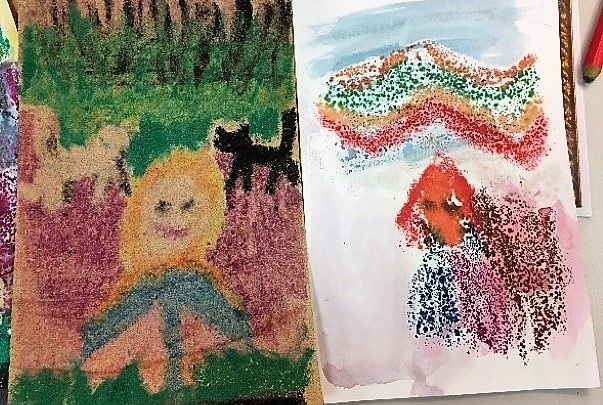UPDATED 4/27/2021
MuseumWeek is coming up June 7-13, and we’re celebrating by looking back at some of our favorite artworks and activities at the museum. We love having changing art exhibits in the Whiteman Family Exhibition Gallery because it gives us an opportunity to share so many beautiful artworks made with a variety of mediums.
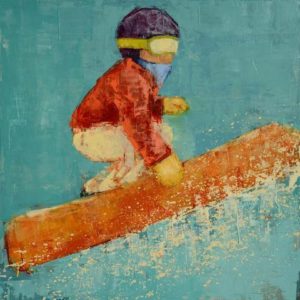
Rebecca Kinkead – Rider (Clear Blue Sky), 2014 Oil and wax on linen – 40 x 40 inches
This artwork by Rebecca Kinkead was installed in The Art of Healthy Living exhibition. The artwork was created by a technique that uses wax and oil paint.
During this 2017/18 exhibition, we shared a similar art process with our visitors on guided tours. We pulled this ”encaustic” or textured art activity (scroll down for materials and directions) from our vault to share with you during Museum Week.
This expressionistic art form is great for self-expression. By using color, line and shape, you can portray emotion through your artwork similar to great artists such as Edvard Munch, Pablo Picasso, Wassily Kandinsky and other expressionist artists from the early 20th Century.
Words to know

Expressionism – a style of art in which the artist tries to express certain feelings through the art. It is more important for the artwork to express feeling or mood than for it to look realistic.
Color – Colors can be used to show a particular feeling or mood. For example, warm colors typically depict rage, anger, celebration, or summertime. Cool colors may typically depict melancholy, depression, seriousness, or the winter season.
Resist – A resist in art occurs when the lines and shapes created with a waxy or oily medium, such as pastels or crayon, literally resist the paint wash. Diluted colors soak into the paper around the pastel lines.
Time to create!
First, let’s gather what you’ll need to create some encaustic art. Be sure to grab a cover for where you will create to minimize any messes.
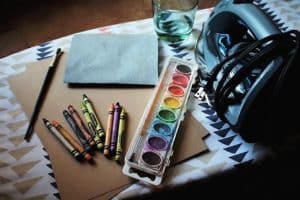
Materials:
- Fine grit sand paper
- Wax crayons
- Sturdy paper
- Watercolors
- Paintbrush
- Iron
- Ironing board or hard heat protected surface
Next, follow these steps:
1. In the foreground of your sandpaper, color using a heavy hand with the crayons to draw a self-portrait or a scene showing an emotion you may feel. Be sure to exaggerate the features, as in the expressionist style, rather than make the image look real.
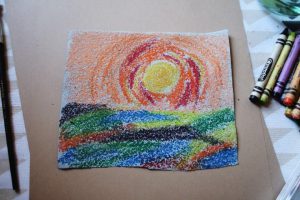
2. When finished with the portrait or scene in the foreground, fill in the background with supporting details or props. Be sure to press really hard with the crayons and layer the colors, so they are thick and dimensional. Remember the colors are not to be realistic, but instead reflect your emotion. You can break the crayons and remove the paper wrap.
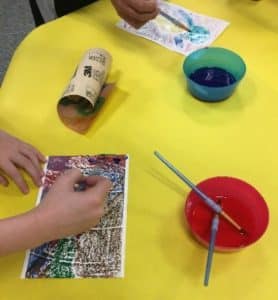
3. This step to be completed by the adult: When you are finished coloring your portrait or scene on the sandpaper, flip the sandpaper in the center of the heavy paper and press a hot iron to the back of the sandpaper until the crayon melts onto the heavy paper. Separate the pieces while still warm and let cool. The image will look textured or “encaustic”.

4. Once your wax has cooled on your heavy paper, wash over the encaustic image with water color to enhance your main emotion color.
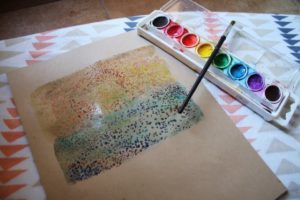
Beyond the art
Now that you have your own expressionistic artwork, you can share them with your family and talk about the emotions you put into your artwork.
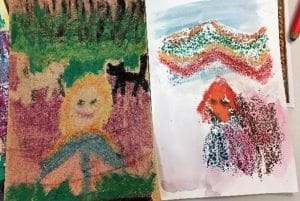
Furthermore, you can research other expressionistic artworks on Google Arts and Culture to interpret them with your new knowledge.
We hope you had fun! Find more art activities on our iArt page.

